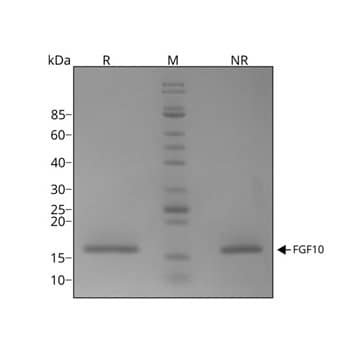Recombinant Human/Rat/Bovine FGF-10, Animal-Free Protein
R&D Systems, part of Bio-Techne | Catalog # Qk003
Human/Rat/Bovine/Porcine

Key Product Details
Product Specifications
Source
E. coli-derived FGF-10 protein
Purity
Single species with expected mass
Endotoxin Level
<0.10 EU per 1 μg of the protein by the LAL method.
Predicted Molecular Mass
17 kDa
SDS-PAGE
Monomeric FGF-10 protein only
Activity
No significant difference between EC50 of reference and test lots
Mycoplasma
Negative when tested in both ribosomal RNA hybridization and luminescence assays
Scientific Data Images for Recombinant Human/Rat/Bovine FGF-10, Animal-Free Protein
Recombinant Human/Rat/Bovine FGF-10, Animal-Free Protein Bioactivity
FGF-10 activity is determined using the firefly luciferase reporter assay (*) in stably transfected HEK293T cells. Cells are treated in triplicate with a serial dilution of FGF-10. Firefly luciferase activity is measured and normalized. EC50 = 0.36 ng/ml (21.1 pM).*Promega pGL4.33[luc2P/SRE/Hygro] #E1340Recombinant Human/Rat/Bovine FGF-10, Animal-Free Protein SDS-PAGE
FGF-10 migrates as a single band at 17 kDa in non-reducing (NR) conditions and upon reduction (R). No contaminating protein bands are visible.Purified recombinant human FGF-10 protein (7 µg) was resolved using 15% w/v SDS-PAGE in reduced (+ beta-mercaptoethanol, R) and non-reduced conditions (NR) and stained with Coomassie Brilliant Blue R250.Formulation, Preparation and Storage
Qk003
| Formulation | Lyophilized from HEPES/NaCl/mannitol |
| Reconstitution | Resuspend in water at >100 µg/ml, prepare single use aliquots, add carrier protein if desired. |
| Shipping | The product is shipped lyophilized at ambient temperature, on ice blocks or on dryice. Shipping at ambient temperature does not affect the bioactivity or stability ofthe protein. Upon receipt, store immediately at the conditions stated below. |
| Stability & Storage | Store lyophilized protein between -20 °C and -80 °C until the date of expiry. Avoid freeze-thaw cycles. |
Background: FGF-10
References
- Beenken, A. and M. Mohammadi (2009) Nat. Rev. Drug Discov. 8:235.
- Igarashi, M. et al. (1998) J. Biol. Chem. 273:13230.
- Emoto, H. et al. (1997) J. Biol. Chem. 272:23191.
- Beer, H.-D. et al. (2005) Oncogene 24:5269.
- Zhang, X. et al. (2006) J. Biol. Chem. 281:15694.
- Min, H. et al. (1998) Genes Dev. 12:3156.
- Rice, R. et al. (2004) J. Clin. Invest. 113:1692.
- Bellusci, S. et al. (1997) Development 124:4867.
- Weaver, M. et al. (2000) Development 127:2695.
- Pirvola, U. et al. (2000) J. Neurosci. 20:6125.
- Sakaue, H. et al. (2002) Genes Dev. 16:908.
- Donjacour, A.A. et al. (2003) Dev. Biol. 261:39.
- Mailleux, A.A. et al. (2002) Development 129:53.
- Makarenkova, H.P. et al. (2000) Development 127:2563.
- Jaskoll, T. et al. (2005) BMC Dev. Biol. 5:11.
- Nomura, S. et al. (2008) Br. J. Cancer 99:305.
Long Name
Fibroblast Growth Factor 10
Alternate Names
FGF10, KGF-2, KGF2
Gene Symbol
FGF10
UniProt
Additional FGF-10 Products
Product Documents for Recombinant Human/Rat/Bovine FGF-10, Animal-Free Protein
Product Specific Notices for Recombinant Human/Rat/Bovine FGF-10, Animal-Free Protein
The above product was manufactured, tested and released by R&D System's contract manufacturer, Qkine Ltd, at 1 Murdoch House, Cambridge, UK, CB5 8HW. The product is for research use only and not for the diagnostic or theraputic use.
For research use only
